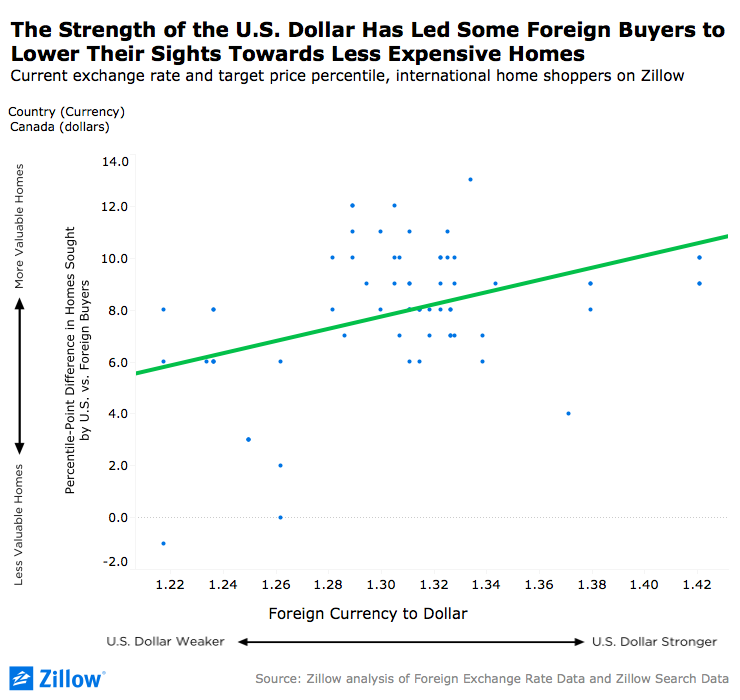As the U.S. Dollar Strengthens, How Do Foreign Buyers Respond?
As the U.S. dollar has strengthened over the past few years, foreign buyers of U.S. homes have responded to the squeeze in different ways. Buyers from some countries have adjusted their sights lower and responded by shopping for less expensive homes, while others have likely dropped out of the market altogether allowing their better-heeled countrymen to seek more expensive places. And still others seemingly haven’t adjusted their behavior at all.
- As the U.S. dollar has strengthened in recent years, U.S. homes have become more expensive for international shoppers.
- Buyers from different countries have responded to this squeeze in different ways: Some have started to seek less-expensive homes, some have dropped out of the market entirely and some others haven’t changed their behavior at all.
As the U.S. dollar has strengthened over the past few years, foreign buyers of U.S. homes have responded to the squeeze in different ways. Buyers from some countries have adjusted their sights lower and responded by shopping for less expensive homes, while others have likely dropped out of the market altogether allowing their better-heeled countrymen to seek more expensive places.
And still others seemingly haven’t adjusted their behavior at all.
Compared to the start of 2015, the U.S. dollar now buys about 30 percent more Mexican pesos, about 25 percent more British pounds, about 15 percent more Brazilian reals, about 10 percent more Chinese yuan, and about 7 percent more Euros or Canadian dollars. These movements mean that homes have become more expensive for international shoppers, above and beyond the added expenses that all buyers – foreign and domestic – have had to cope with as home prices themselves rose.
As the greenback strengthens relative to these currencies, it’s reasonable to expect two things to happen. First, foreign shoppers could begin to shop for less-expensive U.S. homes. And second, more budget-conscious buyers seeking more modest homes to begin with might drop out of the market entirely. Our research indicates that while both of those are happening to some degree among some buyers, not all international home shoppers have responded in the same way to changing exchange rates, and that some groups tend to be more price-sensitive than others.
The figure below compares the target price percentile of five major international home shopper groups in the United States relative to the target price percentile of local home shoppers,[1] and the exchange rate of their origin-country currency to the U.S. dollar.[2] Each point is a randomly selected date between 2015 and Q1 2017.[3]
Fluctuations in exchange rates don’t appear to matter much to buyers from Europe and the United Kingdom. Regardless of the relative strength or weakness of the euro or British pound, these buyers generally shopped for the same kind of homes they always had, targeting a price percentile roughly 15 to 20 percentage points above the typical U.S. buyer.
Our northern and southern neighbors from Canada and Mexico responded similarly to one another to a strong U.S. dollar, and home shoppers from both nations appear to be particularly sensitive to currency exchange rates. As the loony and peso weakened, the cost of homes considered actually rose, suggesting shift among shoppers toward fewer but more affluent Canadian and Mexican home shoppers in the United States.[4]
When the loony was at its weakest, Canadians home-shopping in the United States appeared to have about $100,000 more budget space compared to Canadian shoppers searching when the loony was at its strongest. Similarly, Mexicans shopping for homes in the United States when the peso was at its weakest appeared to have about $50,000 more budget space compared to Mexican shoppers searching when the peso was at its strongest.
Chinese shoppers also appear to be sensitive to currency exchange rates, but in a different (and maybe more predictable) way: As the yuan weakened relative to the dollar, Chinese home shoppers began to shop for somewhat less expensive homes. Between early 2015 and early 2017, the yuan moved from around 6.2 yuan per dollar to about 6.9 yuan per dollar, which is associated with about a budget tightening of about $22,000 by the median Chinese home shopper in the United States.
There are a number of other factors beyond exchange rates potentially influencing the price of homes attractive to Chinese home shoppers in the United States. To begin with, Chinese home shoppers tend to pursue more expensive homes than local shoppers or other international home shopper groups. But starting in late 2016, the government of China began enforcing rules limiting the amount of foreign currency Chinese nationals can buy – limiting the amount of foreign cash they can have which they could then use to buy a home in another country. The Chinese government also recently started outright prohibiting certain international home purchases.
The case of Brazilian shoppers is less conclusive: There is no statistically significant relationship between the real/dollar exchange rate and the target price of Brazilian home shoppers over the period we studied. Unlike the other currencies we examined, which generally weakened over the past two plus years, the real first weakened and then strengthened. In both mid-2015 and early 2017, the real/dollar exchange rate was at similar levels. But in 2015, Brazilian home shoppers on Zillow targeted a much lower price point (around the 59th percentile of homes for sale at that time) than during the more recent period (around the 65th percentile of homes for sale).
[1] On each date, we compare the behavior of foreign home shoppers on Zillow with U.S. home shoppers, taking the difference in the median percentile of homes viewed by each group. We do this to ensure the analysis does not conflate behaviors driven by user engagement with the website or available listings with behaviors specific to specific international home shopping groups.
[2] For each date, we rank all listings on Zillow by their list price, grouping them into percentiles. We then compute a median target percentile based on the listings viewed by Zillow users in each country weighting by the number of users from a particular country who view a particular listing on a particular date. This approach allows us to control for the different types of markets where shoppers from each country tends to focus and the shifting composition of homes for sale over time.
[3] Random sample of 30 days each in 2015 and 2016, and eight random days in Q1 2017.
[4] Both relationships are statistically significant.

